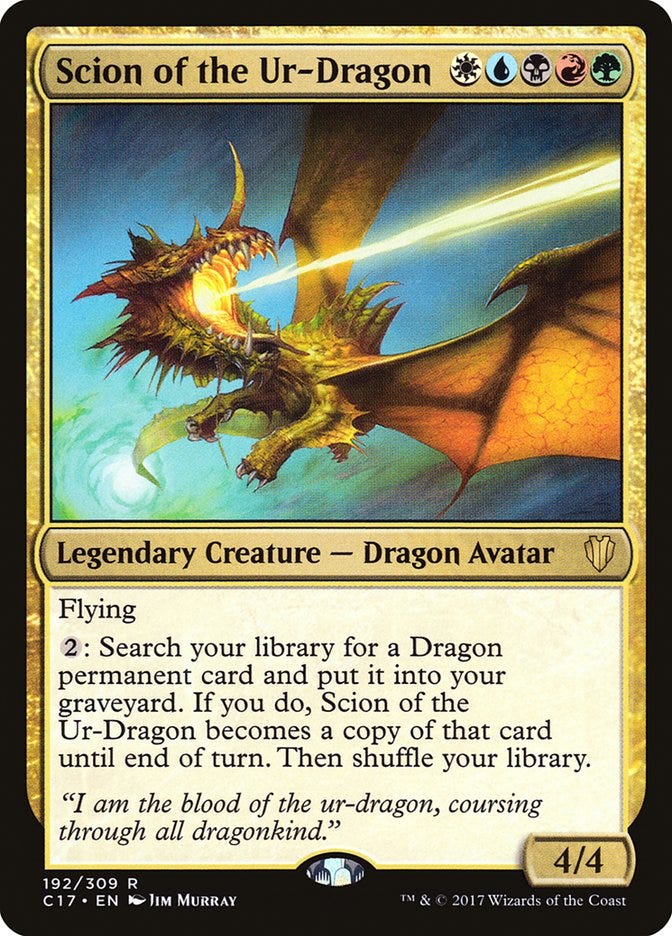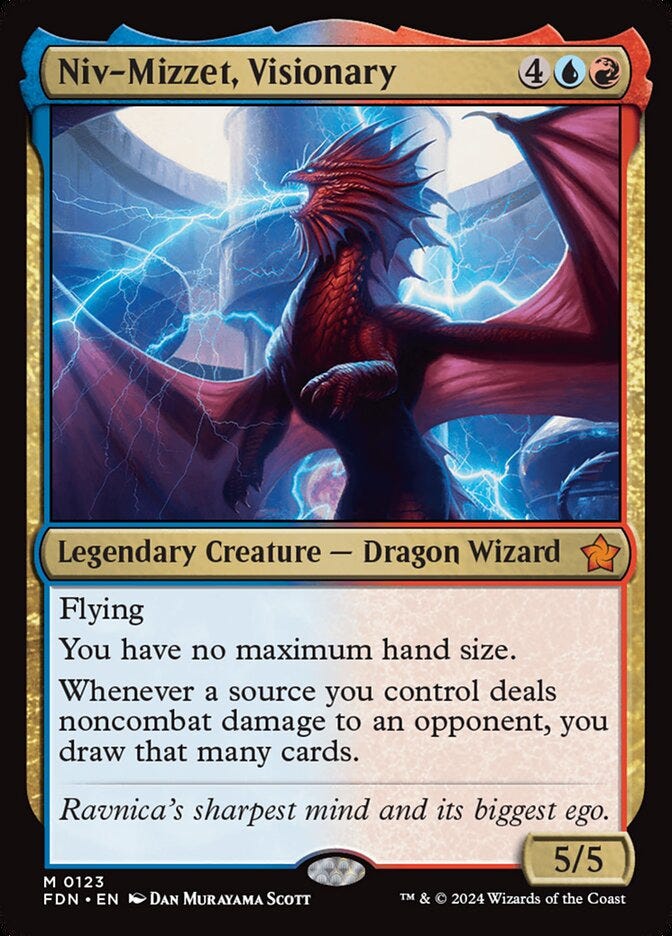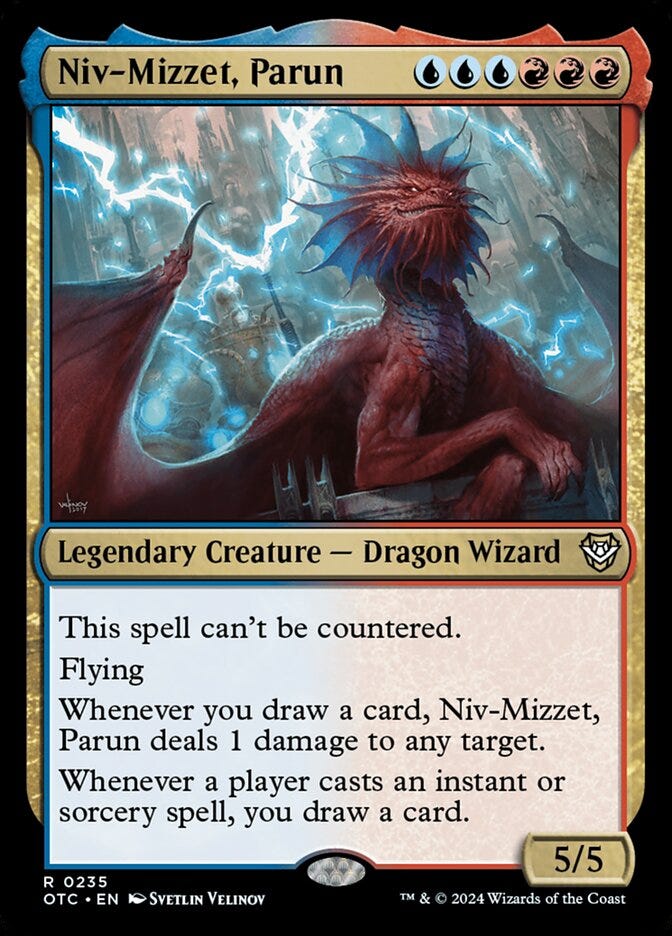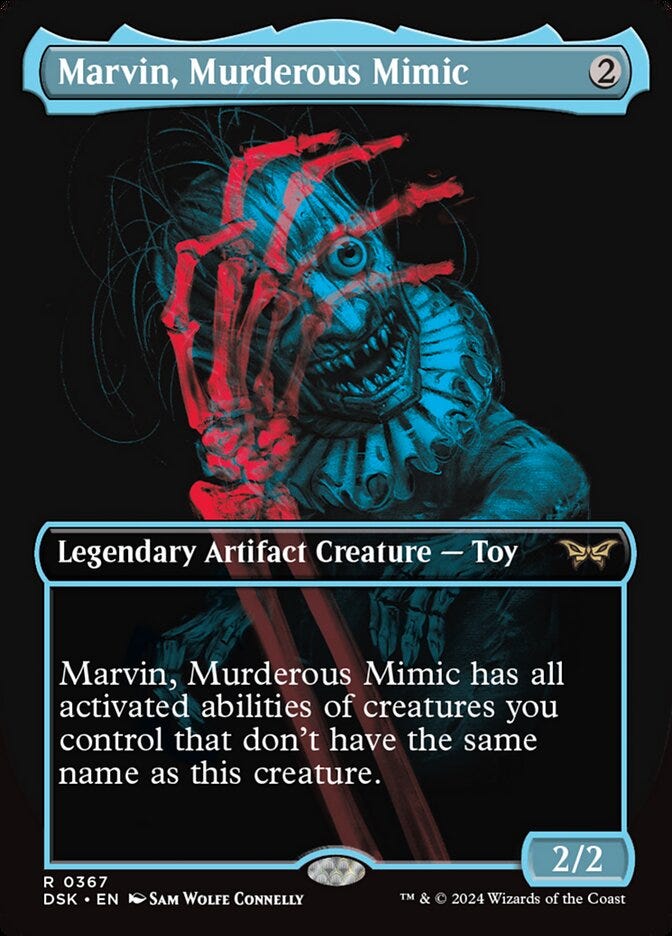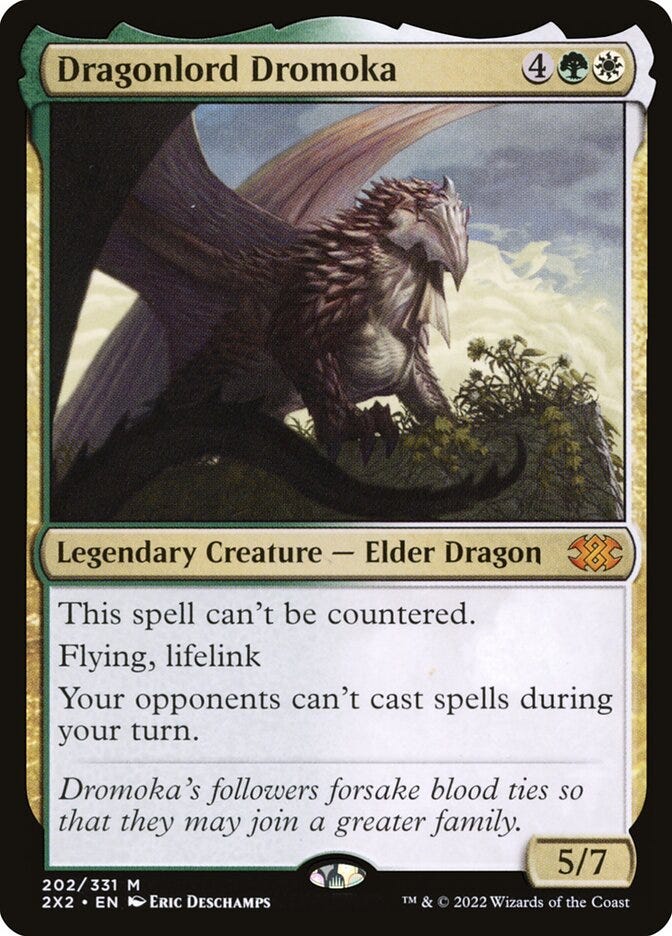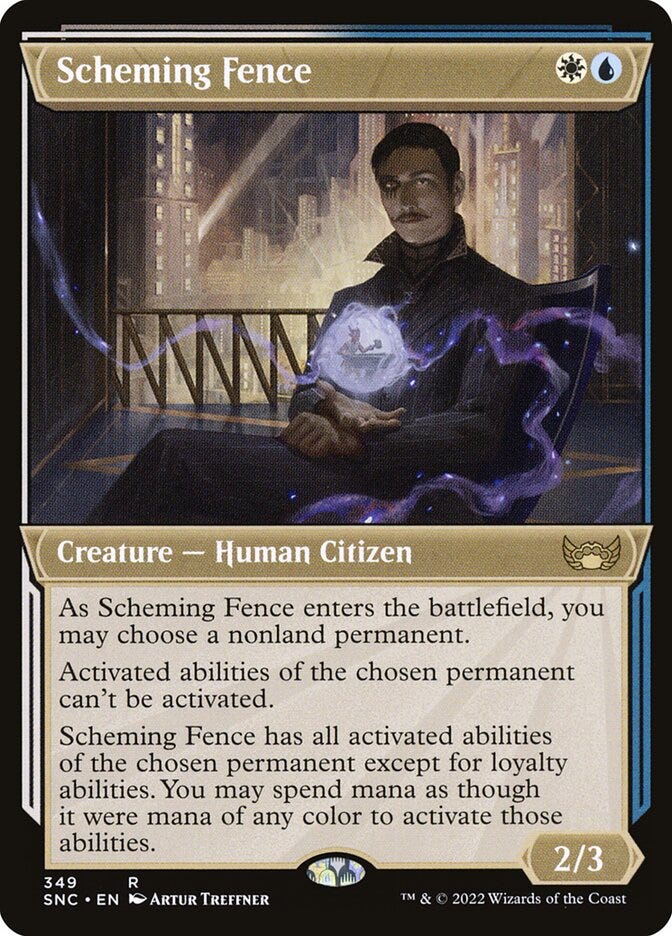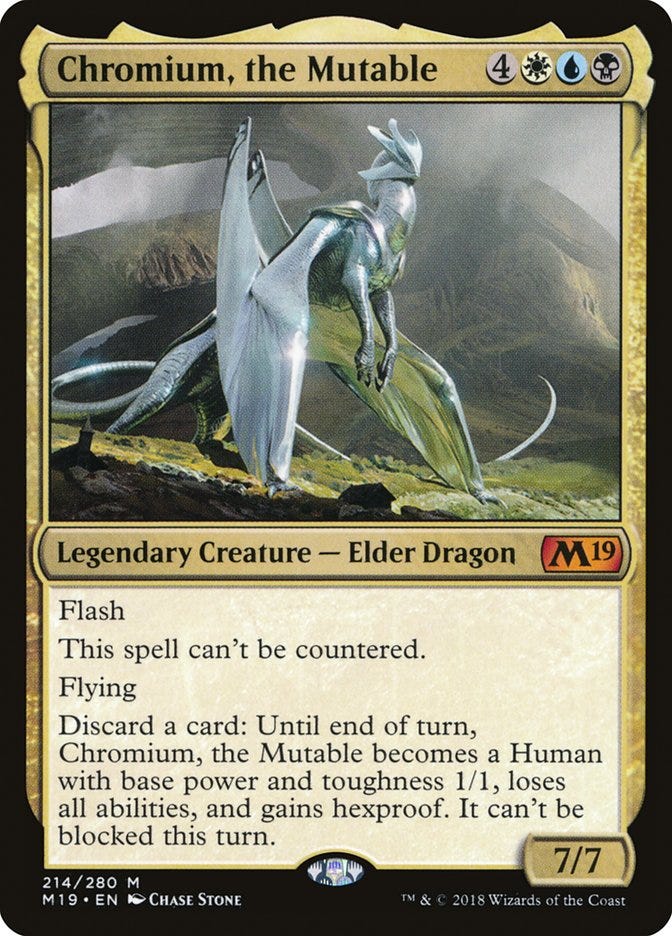Scion of the Ur-Dragon in the New Meta
With every new set comes an array of powerful cards. Inevitably, something comes out to evolve an already existing deck, format, or inspire a new deck all on its own. Scion of the Ur-Dragon evolved recently with the addition of Niv-Mizzet, Visionary. This article will go over: my personal findings competing with the deck, how I approached brewing the deck, the changes that Niv-Mizzet, Visionary brought to the table, and Scion of the Ur-Dragon’s new identity as a competitive commander.
What Changed
With the addition of Niv-Mizzet, Visionary, Scion of the Ur-Dragon gains access to a win condition using only dragons that aren’t as high-risk as Worldgorger Dragon. Where, more recently, Scion of the Ur-Dragon has been viewed as a 5 color “good stuff” deck that got value off of cards like Ancient Silver Dragon. Scion of the Ur-Dragon can now become its own unique threat to the table in a hard to interact with way. With Niv-Mizzet, Parun and Niv-Mizzet, Visionary, we get an effect that acts like the classic Parun plus Curiosity combo. This combo utilizes Parun’s ability that allows you to deal damage when you draw a card. If Parun has Curiosity attached, damaging an opponent with its ability causes you to draw, then deal damage, and loop from there until you damage yourself or a creature. With these cards on the battlefield, we can damage our opponents and draw our entire library while being hard to interact with. If an opponent tries to stop this, Niv-Mizzet, Parun will simply trigger the combo again if an instant is cast, which is the most common form of interaction. Alternatively, if the interaction isn’t an instant, we can always cast our own instant to reset the combo without having to deal with what our opponents do. We also don’t need to worry about decking out as we have full control on where the damage goes. With one card in deck, we can hit either Niv-Mizzet, or yourself, to stop the combo. We don’t need to worry about being decked out as you simply cast Angel’s Grace, draw the one card we left off of the Parun trigger, and it resolves due to Split-Second making it virtually impossible to stop. If the damage doesn’t win, we can always play Thassa’s Oracle with the help of cards like Borne Upon a Wind to give us flash on all of our spells. Now that we have no cards in our deck after the combo, this wins the game.. Thassa’s Oracle also gives us a definitive win if an opponent has protection from damage effects like the ones granted by The One Ring or Angel’s Grace.
The Brew
Upon the release of Niv-Mizzet, Visionary and its inclusion, Scion of the Ur-Dragon had the opportunity to power-up via a massive overhaul of the deck. Changing the deck’s identity and main win condition requires identifying exactly what we want the deck to become and what the deck is capable of. Step one was finding the best ways to get the “Double Niv” combo onto the field. One Niv-Mizzet can always be Scion of the Ur-Dragon via its activated ability. We can always activate twice then Reanimate the other Niv-Mizzet since our commander sends the original dragon to the graveyard with its ability. Shallow Grave is a card often played in Scion of the Ur-Dragon for immense value, and instant reanimation is powerful in itself. Duskmourn presented us with an amazing addition, Marvin, Murderous Mimic. Marvin has the activated abilities of all our creatures in play, we can activate Marvin first for one Niv-Mizzet and our commander for the other. This combo uses only activated abilities, making it very difficult to interact with. If you have any excess mana, you can simply reactivate if an opponent does anything to respond.
The ability to activate Scion of the Ur-Dragon in response to anything our opponents may do makes infinite mana powerful for our commander. If we get access to simply infinite colorless, we can lock in a win no matter how many answers a player has aside from Split Second spells. Our outlet, after we establish infinite colorless mana, is Bhaal’s Invoker. Although this card definitely isn’t good on its own, it wins us the game as an outlet for our infinite mana. Our commander searches this out and that makes it a very confident inclusion in the deck.
With our win conditions established we have every option to get infinite mana as we are in 5 colors. This can be very daunting due to the sheer amount of options. Pick and choose any infinite mana combos you’re comfortable with. I recommend two card combos generally; the harder to stop, the better. If our commander is on the battlefield, We can protect the set up of our infinite mana via Dragonlord Dromoka’s Silence like effect on our turn. On the following turn’s upkeep our commander is no longer Dromoka and we can make infinite mana. At that point we can activate Scion of the Ur-Dragon as much as we need, then burn out the table.
We are not a turbo deck. We need means for slowing down our opponent’s game plans, otherwise we will never get the chance to win. Drannith Magistrate is a must-have piece that stops the powerful Underworld Breach combo. If Drannith Magistrate is on the battlefield early enough, it can stop commanders from being cast, stopping some decks in their tracks. I am of the mindset that we should not run cards that hard stop our deck if copied as there are a lot of good copy effects out there. Even though Drana and Linvala and Cursed Totem are very strong, we deliberately exclude them from our list.
The Ur-Dragon proper is a niche add that allows you to put out permanents via a triggered ability. Being a deck that wins off of permanents, We very much want this. The exclusion of Ancient Copper Dragon is a difficult one. You could very well find a good reason to include it, but with the choice of making d20 treasures or with Old Gnawbone making a minimum of seven treasures, its inclusion felt redundant. Ancient Silver Dragon, on the other hand, draws cards and that simply has more value in a format based on card quality. Hitting a 5 on a d20 still feels good with Ancient Silver Dragon. A 5 on Ancient Copper Dragon makes me feel like I should have just grabbed Old Gnawbone. Old Gnawbone also has the novel interaction with two of our mana producing creatures. The Hierarch’s exalted ability gives +1/+1 on attack trigger, giving us more treasure.
The most niche interaction we have in the deck comes from Scheming Fence. This two mana creature gives us an opportunity to win similarly to Marvin lines. Scheming Fence enters choosing Scion of the Ur-Dragon. We activate Scheming Fence’s ability obtained from Scion of the Ur-Dragon to become Niv-Mizzet Parun. Then Scheming Fence’s static ability to suppress Scion of the Ur-Dragon is gone as it is currently a dragon. We are then able to activate Scion of the Ur-Dragon proper to grab Niv-Mizzet, Visionary to start our combo.
Post Tournament
The deck performed above expectations. The first game we won despite not being able to cast noncreature spells due to a Ranger-Captain of Eos activation. While our creature only win condition isn’t our plan A, having the deck be at least capable of it made me feel very confident in its ability to win despite significant setbacks.
In another game, there was a significant moment where we needed to win at instant speed. Our opponents realized that we were likely to win during our next turn and cast an Eldritch Evolution in an attempt to grab Opposition Agent. This effectively stops any search we may want to do with our commander. The player in the seat after mine had been accruing cards all game and was likely to win on his next turn. I also had no removal in hand to deal with an Opposition Agent once it was in play. Noticing that this might be my only window to win, we activated Scion of the Ur-Dragon in an attempt to grab Parun. We also had a Magda, Brazen Outlaw in play with more than 5 treasures we had made due to Smothering Tithe. After stopping a few attempts to remove our commander, we eventually assemble our Double Niv combo, cast an instant spell and win the game from there.
Niv-Mizzet, Visionary over performed by so much it is the primary win condition now. We only threatened infinite mana once or twice but one of which was to bait more interaction and it worked. The other time it was stopped. Ioreth of the Healing House didn’t feel as good as I would have liked. Most of the time it ended up being a pitchable card to Force of Will and seeing no other situations where we needed to see it on the battlefield. Perhaps if we include Enduring Vitality, Ioreth will feel stronger when in play. Scheming Fence combo simply didn’t come up. With 99 cards in deck, sometimes this happens. I will have to report on that card at a later time.
The deck performed really well with its core game plan. It felt like a midrange combo deck that can force its own window efficiently. It can also wait and try to win in response to another player’s wins quite well, leaving it very flexible in its game plan.
It was a judgement call not to run any searchable dragons that could protect Scion of the Ur-Dragon from removal. I intend to put in Chromium, the Mutable as I find it a good idea to have a searchable option to protect our commander. Aside from simply protecting our commander, Chromium has an activated ability that gives the card hexproof. This way of obtaining hexproof allows our commander to keep hexproof, even if it becomes another dragon. Due to Chromium’s activated ability, we can activate our commander twice, become Chromium and give hexproof for the first search. For the second search our commander can become any dragon we need at the time. Chromium allows us to respond to removal in a way that gives us flexibility in which dragon we want to leave our commander as for the turn. This makes Chromium the best searchable option to protect our commander in my opinion.
This new iteration of Scion of the Ur-Dragon is still young and in need of refinement. I highly encourage any aspiring Scion of the Ur-Dragon players to experiment and try new things to further develop the deck. The core idea is powerful and difficult to interact with. With time I believe we will see more of this deck performing well in top 16s of events. Though this is how I feel right now, with the potential unbannings on the horizon, the future meta is uncertain. Having Niv-Mizzet, Visionary at our disposal, I am sure Scion of the Ur-Dragon can survive and thrive through the coming storm, whatever changes they may bring.
Click Here for Scion of the Ur-Dragon Tournament List



